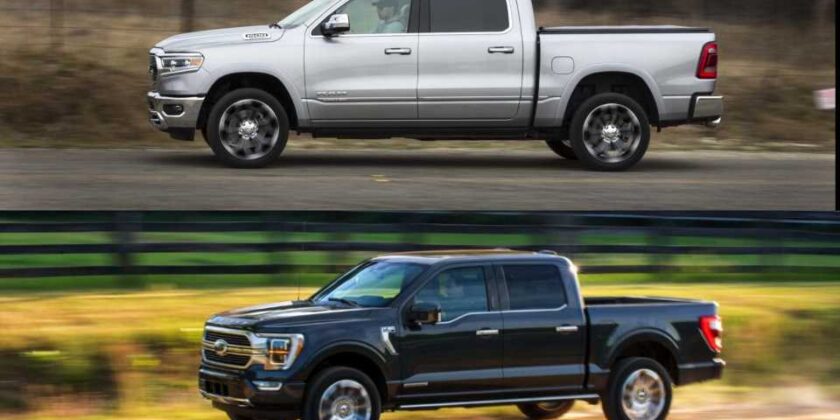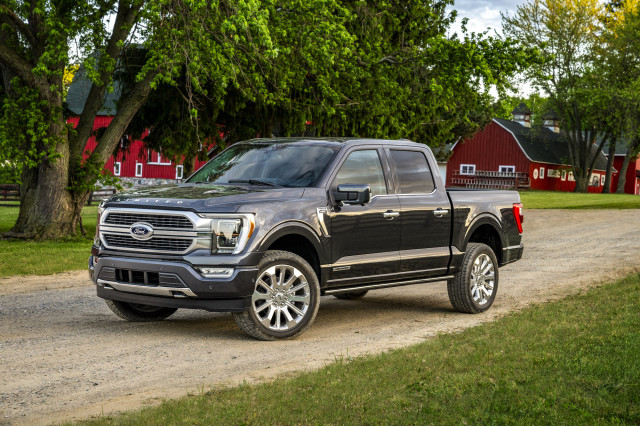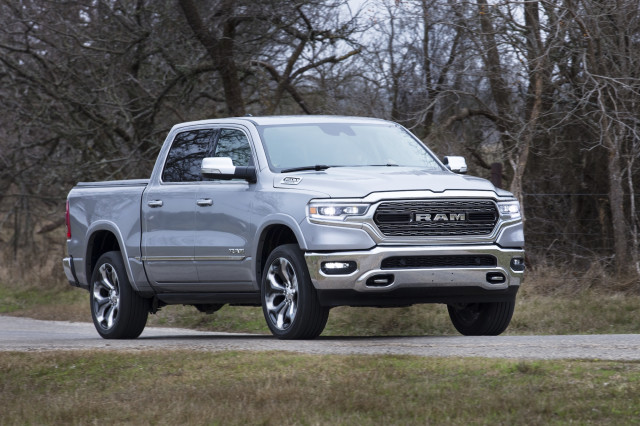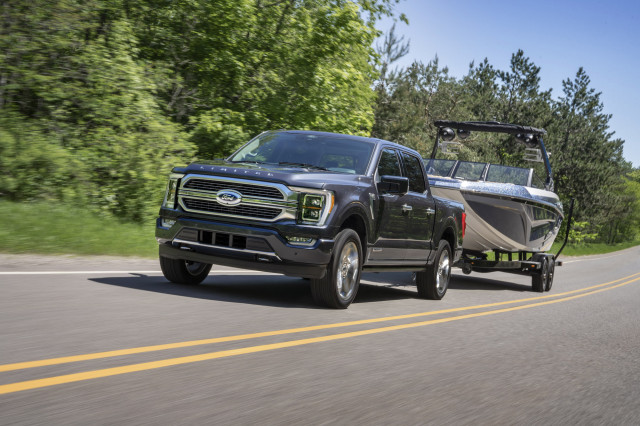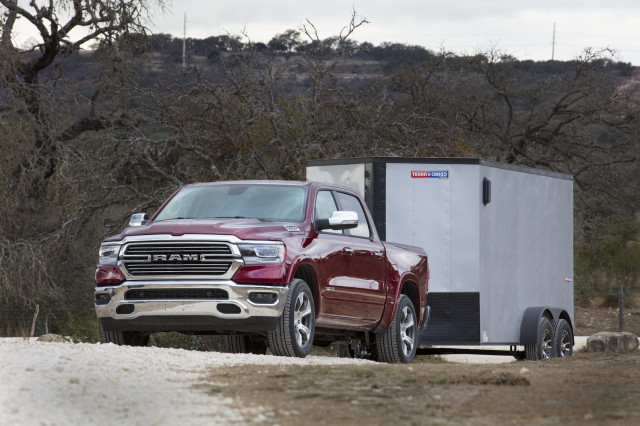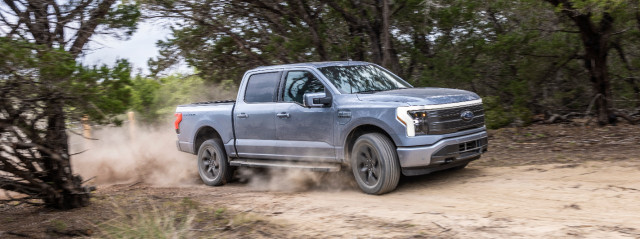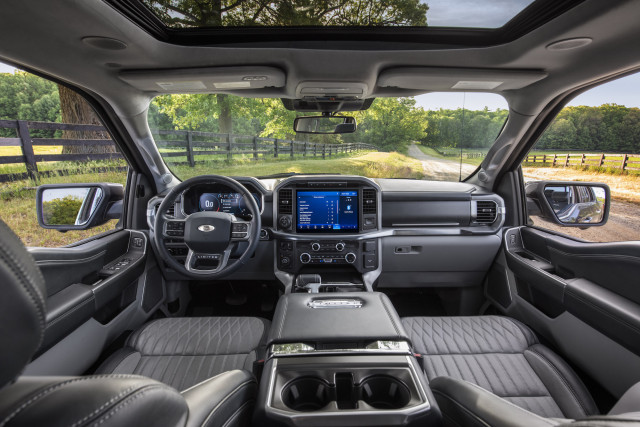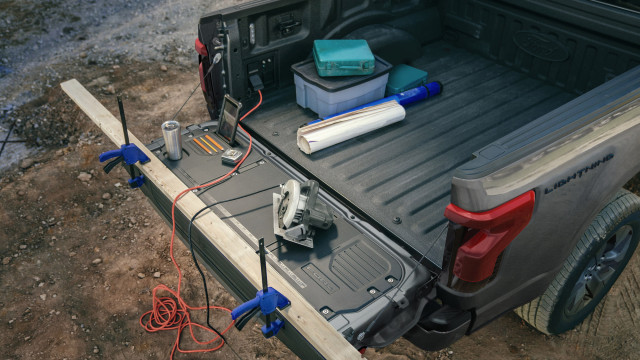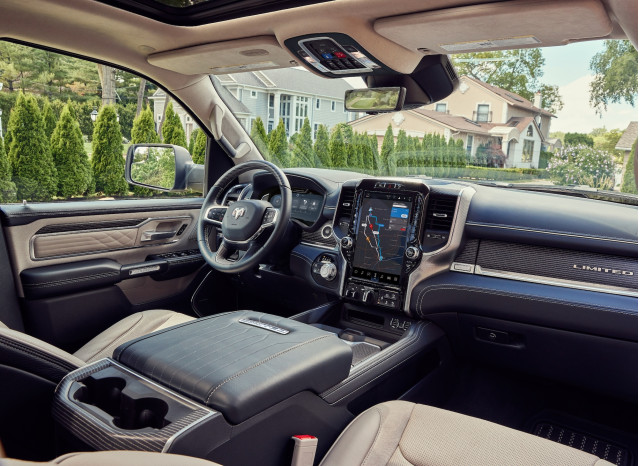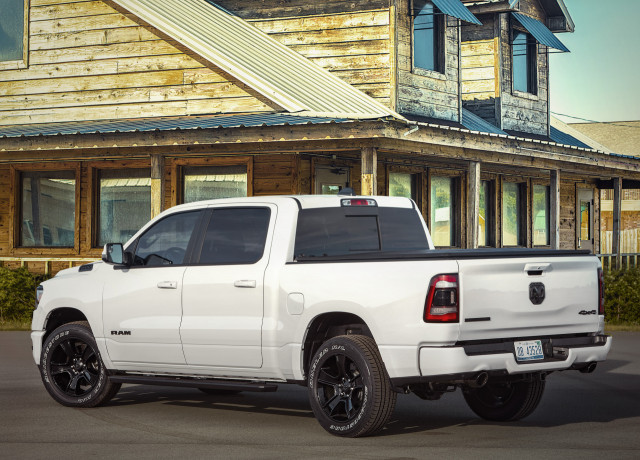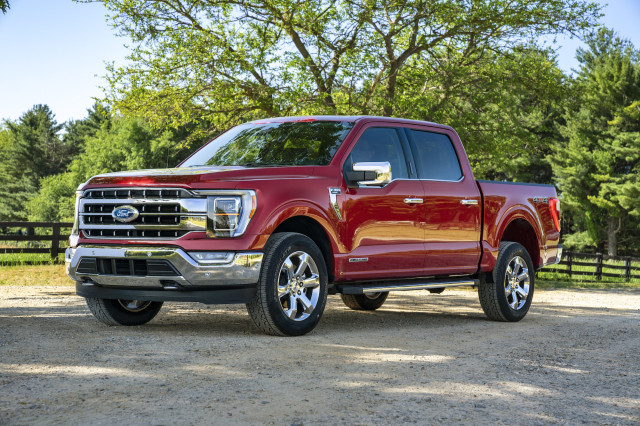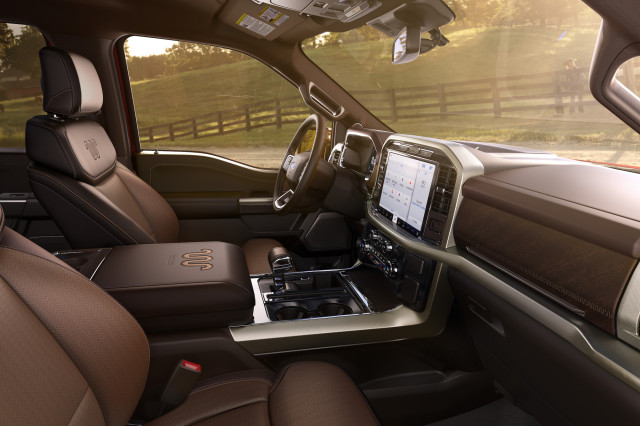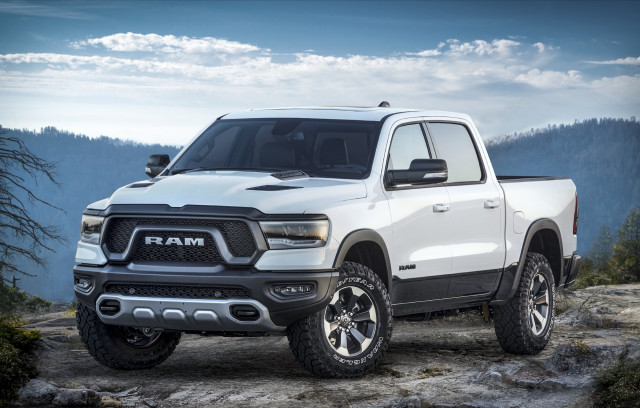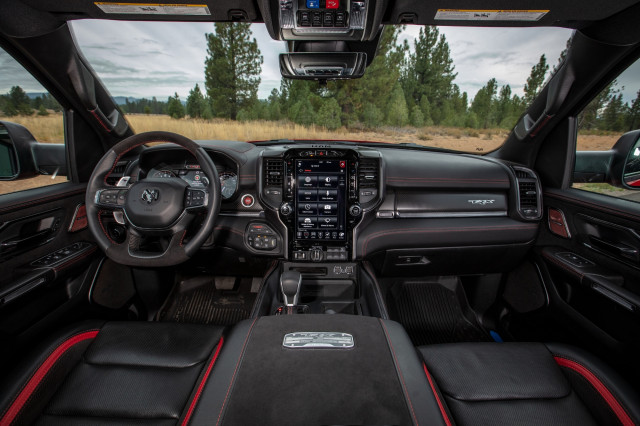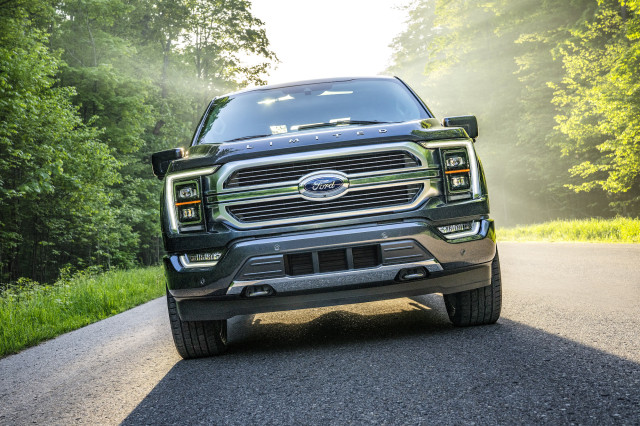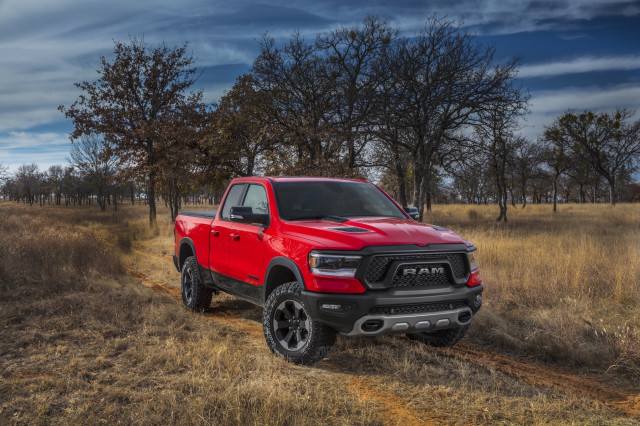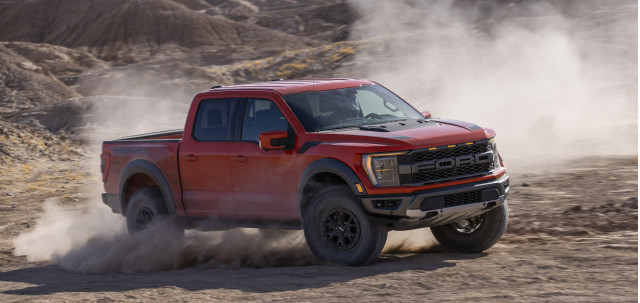The full-size pickup truck segment reflects the changes sweeping through the automotive industry. The bestselling Ford F-150 was first to be offered with a hybrid powertrain and as a fully battery electric truck in the F-150 Lightning. The Ram 1500 Revolution EV won’t arrive until 2024, but Ram was the first to introduce a coil spring rear suspension that helped take pickup trucks from the worksite to carpool lanes as a family vehicle.
Both trucks span the spectrum from basic utility vehicles to luxury land yachts tipping into six-figure prices. The 2023 Ford F-150 aims to keep its decades-long lead over other trucks with seven powertrain choices, nearly a dozen trims, as well as a high-performance Raptor R meant to compete with the Ram 1500 TRX.
Unable to stand pat, the 2023 Ram 1500 offers even more luxurious options with a larger 12.0-inch digital instrument cluster and a Limited Elite package that has a suede-like headliner, leather seats, heated and cooled front seats, and a multifunction tailgate.
Both trucks have their merits and more than enough capability, but which one does it best?
Ford F-150 vs. Ram 1500 trims and prices
The F-150 XLT crew cab with four-wheel drive costs about $50,000
The Ram 1500 Big Horn costs about the same as the XLT, but isn’t as well equipped
Best picks: F-150 XLT, Ram 1500 Laramie
2023 Ford F-150
How much is a Ford F-150?
With as many as seven powertrain options, three cab sizes, three bed lengths, and eight trims, the bestselling vehicle in America can be configured in a multitude of ways, starting around $35,000 for a basic work truck with a regular cab to a loaded six-figure Lightning Platinum.
Stepping over the base XL mostly reserved for fleet purchases, the 2023 Ford F-150 XLT costs about $44,000, including destination, and includes features such as alloy wheels, cloth seats, power windows, an 8.0-inch touchscreen, cruise control, and standard crash avoidance tech such as automatic emergency braking and active lane control.
At the opposite end of the spectrum is a loaded Limited for just under $90,000. It comes with a V-6 hybrid powertrain and indulgences that range from the convenient, such as power running boards and an onboard scale, to the cosseting, like massaging seats and BlueCruise limited hands-free driving system.
A fully loaded, fully electric F-150 Lightning Platinum for just under $100,000. It comes with the extended-range battery pack with a 300-mile range, and most of Ford’s best trailering equipment and tech, ranging from BlueCruise to a Bang & Olufsen sound system.
To top it all off is the F-150 Raptor R and its 700-hp 5.2-liter supercharged V-8 that costs more than $110,000. How’s that for range?
2023 Ram 1500
How much is a Ram 1500?
While it might seem outrageous, Ford’s price delta for its popular truck is mirrored by the Ram 1500, with a range-topping performance beast in the Ram TRX. It has a 702-hp 6.2-liter supercharged V-8, and a loaded price that exceeds $100,000 but comes up short of the Raptor R.
There are more reasonable Rams as well, but the brand separates out its fleet-oriented model as a Ram 1500 Classic that costs about $32,500. It’s a throwback dating back to 2009, with analog gauges, a dinky 5.0-inch touchscreen, a regular cab, and an 8-foot bed, and lacking any driver-assist features. It’s old enough to be called a Dodge Ram.
The more modern Ram 1500 Tradesman starts just under $40,000. It can be had with an extended cab with a 6-foot-4 bed or a crew cab with that long bed or a smaller 5-foot-7 bed. The features are as limited as the Classic, but it has power locks and windows and keyless entry.
The Big Horn with a Level 1 equipment group matches up with the F-150 XLT, but the Laramie comes with an 8.4-inch touchscreen, heated and cooled power front seats trimmed in leather, remote start, and automatic emergency braking. It starts at about $55,000 for the crew cab and short box, and four-wheel drive adds nearly $4,000.
It feels more refined than the F-150, but Ram’s top Limited trim starts at a lower price than Ford’s Limited. The downside is Ram uses more optional and expensive packages including one with adaptive cruise control.
Advantage: Ford F-150, for more trim choices and fewer options packages.
2023 Ford F-150
Ram 1500 vs. F-150 performance and towing
The F-150 has V-6, V-8, hybrid, and electric powertrains
The Ram is limited to a V-6, a V-8, or a turbodiesel
The F-150 tows more than the Ram 1500
Skipping over the F-150 Raptor R and Ram 1500 TRX performance beasts for the everyday, both trucks start with a V-6, but Ram equips its 305-hp 3.6-liter V-6 with an onboard starter generator or mild hybrid to ease the electrical load as well as add a torque kick off the line.
The V-6 difference
Base Ram has a 305-hp 3.6-liter V-6 that can tow 7,710 pounds
Base Ford F-150 has a 290-hp 3.3-liter V-6, 8,200-pound tow rating
Ford’s 2.7-liter turbo V-6 makes 325 hp and 400 lb-ft of torque, tows up to 10,100 pounds
It’s more powerful than Ford’s base 3.3-liter V-6 but Ford is full of options, including a punchy 2.7-liter turbo V-6 that makes 325 hp and 400 lb-ft of torque. Ford also offers a higher performance 3.5-liter twin-turbo V-6 that generates 400 hp and 500 lb-ft. It’s surprisingly quick, and with the 10-speed automatic transmission offered throughout the F-150 lineup, it balances great power with good efficiency, and has the highest tow rating in the lineup of 14,000 pounds.
Have a V-8?
Ford’s 5.0-liter V-8 makes 400 hp and 410 lb-ft, tows up to 13,000 pounds
Ram’s 5.7-liter V-8 makes 395 hp and 410 lb-ft, tows up to 12,570 pounds
Neither brand’s V-8 can compete with that, and with the no-compromise advances made in V-6 truck powertrains, the V-8 almost feels like a legacy offering. Like Ram’s V-6, the V-8 is a mild-hybrid system that mostly runs the accessories, but it can’t quite match the Ford V-8. Ram uses an 8-speed automatic in its gas trucks, and it’s more certain than Ford’s quick-acting 10-speed.
2023 Ram 1500
Diesel and Hybrid options
Ford and Ram use different approaches to improve efficiency without sacrificing capability.
The F-150 Hybrid takes the twin-turbo V-6 and binds it to a 47-hp electric motor powered by a 1.5-kwh lithium ion battery. Output bumps up to 430 hp and 570 lb-ft, but the extra weight lowers the towing capacity to 13,000 pounds. It can drive on electric power alone at light and low speeds of up to about 10 mph, but the power transfer can be coarse compared to the twin-turbo V-6. A key advantage is an onboard generator that can run power to four 120-volt and one 240-volt outlets for up to 32 hours. The Hybrid is only available on Lariat grades and above, for $3,300 more than the 2.7-liter V-6.
Ram’s 3.0-liter V-6 turbodiesel makes 280 hp and 480 lb-ft so it makes sense in theory, but not in practice. It tows about 200 pounds more than the V-8 but costs about $5,000 more. It’s remarkably smooth and quiet for a diesel and might make economic sense for frequent highway towing, but diesel’s had its knocks in the past decade.
Handling
With such an array of powertrains and options, it’s hard to make a blanket statement about which truck handles best. Both the Ram and Ford have a double wishbone suspension that keeps the front of the truck steady on the road. The difference comes in the back.
The F-150 uses two different types of leaf-spring suspension systems with a solid rear axle and plenty of bounce over road surfaces, even with a laden bed. It can bound over bumps and wobble over pavement seams. An available adaptive suspension on the Max Tow package provides more stability when towing.
Overall, the Ram delivers a softer, comfier ride due to its standard coil springs on the rear suspension. Opt for the available four-corner air suspension and it smooths out the ride even more, but it still won’t be mistaken for a luxury SUV.
Advantage: Ford F-150, for the multitude of options.
2023 Ford F-150 Lightning
Ford F-150 vs. Ram 1500 fuel economy
Ram 1500 turbodiesel nets 21 mpg city, 29 highway, 24 combined
Ford F-150 Hybrid gets 25 mpg combined, or 23 mpg combined with 4WD
Ram’s turbodiesel gas mileage outpaces the F-150 Hybrid
To combat ever-increasing fuel economy regulations, Ram uses a mild-hybrid generator to ease the electrical load on its gas engines, except on outdated Ram Classic models. Until the Ram Revolution electric truck arrives, the 3.0-liter turbodiesel is the most efficient Ram 1500, with an EPA-rated 21 mpg city, 29 highway, 24 combined, which is pretty good for a four-wheel-drive truck.
Ram V-6 gets up to 20/26/23 mpg, or 21 mpg combined with 4WD costs
Ram V-8 returns 18/23/20 mpg, or 19 mpg combined for 4WD
The TRX guzzles fuel at a rate of 10/14/12 mpg
The turbodiesel is more efficient than the Ford F-150 Hybrid, which has a 25 mpg rating across the board but only 23 mpg with four-wheel drive.
F-150’s 2.7-liter V-6 gets 20/26/22 mpg
The base 3.3-liter gets 19/24/21 mpg
Twin-turbo V-6 gets 18/24/21 mpg, and drops to 18/23/20 mpg with 4WD
Ford’s V-8 has a rating of 17/24/19 mpg, or 18 mpg combined with 4WD
Advantage: Surprisingly, the Ram 1500 is a bit better with fuel in most measures.
2023 Ford F-150
2023 Ford F-150 Lightning
2023 Ram 1500
2022 Ram 1500
F-150 vs. Ram 1500 cabs, cargo space, and bed sizes
Ram 1500 has a 5-foot-7 bed or a bigger 6-foot-4 box
Ford F-150 has 5-foot-6, 6-foot-6, or an 8-foot option, but not with a crew cab
The Ram only has a regular cab in Ram Classic models
What kind of cabs are in the Ram 1500?
The Ram Classic is the only Ram truck with a regular cab. The Ram 1500 Tradesman starts with an extended cab that sits three in the front and three in the back, and it pairs with a 6-foot-4 box. Interior cargo volume measures out to 53.3 cubic feet, and there’s 35.6 inches of legroom in back, but in front or back, the middle passenger best be a little passenger. The extended cab has a short-bottomed bench seat in back that flips up in sections to reveal extra storage, but the vertical backrests are less than comfortable for longer trips. It can also be fitted with a crew cab with the same bed size or a 5-foot-7 short box.
Ram 1500 crew cab
The Ram 1500 crew cab also seats six but with much better legroom (45.2 inches) in back due its 68.5 cubic feet of space. The Ram makes great use of interior space with upper and lower glove boxes, a reconfigurable center console deep enough to store a laptop, and in-floor storage boxes in the rear.
What kind of cabs are in the Ford F-150?
The F-150 can be configured with regular, extended, or crew cabs. Each of those offers at least two if not three bed lengths, with the regular and extended cabs getting either a 6-foot-6 or 8-foot bed; the crew cab offers 5-foot-6 or 6-foot-5 beds. The base regular cab has a split bench seat with cloth upholstery, while XLTs add a locking center console in the fold-down middle portion. It seats up to three and there’s no back seat.
Extended cabs get a choice of bucket seats and a front console, along with rear-hinged rear doors and a straight-backed rear bench seat that’s not spacious or comfortable for more than a cross-town trip. The rear is decidedly smaller than the Ram 1500, and has only 33.5 inches of legroom.
Ford F-150 crew cab
The F-150 crew cab has spread-out space in all directions, but not as much as the Ram 1500. Legroom sits at 43.6 inches in back, and Ford mirrors the Ram 1500 with top trims that get leather upholstery, power-adjustable heated and cooled front seats, and reclining front seats for in-truck napping. Ford does in-truck storage a bit better, however. The center console can be fitted with a fold-down shift lever and fold-out work table. Pockets, bins, and cubbies under the seats act like cargo pants.
Cab sizes also affect the size of the fuel tank, with regular and extended cab F-150s and Ram 1500s having a 23-gallon tank, while crew cab models have a 26-gallon tank. A 36-gallon tank can be had on extended F-150 models.
Which truck has the better bed?
Tough call. Spray-in or drop-in bedliners are just the start: cargo tie-downs, bed lighting, a power-sliding rear window, and a power tailgate can be had on both trucks. Ford has a bed-mounted generator, power outlets, built-in rulers, bottle openers, and a bed step with a retractable handle that’s more cumbersome than GM’s integrated bumper steps. Ram offers a multipurpose tailgate that drops open, swings on a side hinge, or splits in the middle.
Ram’s 5-foot-7 box has 53.9 cubic feet of volume
Ford’s 5-foot-6 box has 52.8 cubic feet
Ram’s 6-foot-4 box has 61.5 cubic feet
Ford’s 6-foot-6 box has 62.3 cubic feet
Ford’s 8-foot box has 77.4 cubic feet
Advantage: Ram 1500 is roomier on the inside.
2023 Ford F-150
2023 Ford F-150
2023 Ram 1500
2023 Ram 1500
F-150 vs. Ram 1500 styling
Basic work trucks are just that
Ram Laramie Longhorns and Limited grades are executive level
Ford’s myriad exterior looks offer the most choice
The Ram 1500 left its tractor-trailer front end in the past for a more streamlined but also more anonymous look to appeal to more than just the traditional truck buyer. A bulging hood overlooks an array of grille options, glimmering with chrome or menacing in black, with five different looks for its seven trim lines, most of which have giant Ram lettering spread across the front.
Inside, the Ram plays the role of the boss, with Laramie Longhorns and Limited showcasing leather upholstery and open pore wood trim seemingly taken right from the ranch.
The F-150 has a more functional, utilitarian interior, though higher trims aspire to Ram’s seat on the Board. Ford’s dash is a bit bolder, and can be equipped with 8.0-inch or 12.0-inch touchscreens. Ram’s 8.4-inch touchscreen is better integrated than its vertically oriented 12.0-inch touchscreen that dips down to the center console.
On the outside, the F-150 comes in 15 different wheel and color choices, as well as 11 different grille choices. It’s classic F-150 after that, however, with C-clamp running lights bookending the front, a window step on the front doors, and jarhead ends everywhere else.
Advantage: Ford for the exterior, Ram for the interior.
F-150 vs. Dodge Ram safety
Crew cabs get five stars from the NHTSA
The F-150 comes with standard driver-assist tech
The Ram 1500 does not
2023 Ford F-150
How safe is the Ford F-150?
The F-150 earns a five-star rating from the NHTSA in any of its three cab sizes. Only the Ram 1500 crew cab does the same; the extended cab gets four stars.
Similar results come from the IIHS: The Ram 1500 crew cab earns a Top Safety Pick but only on top trims equipped with automatic emergency braking and LED projector headlights; the extended cab has “Good” crash ratings, but not special accolades.
The F-150 is a more solid safety pick. Both extended and crew cab models earn a TSP with Lariat and above grades with a 502A package that upgrades the headlights to LED projector lamps.
Ford also equips the F-150 with standard driver-assist features such as automatic emergency braking and active lane control across the board. Available features that come standard on higher trims include blind-spot monitors, parking sensors, a surround-view camera system, and adaptive cruise control. Another option is Ford’s BlueCruise system that allows for limited hands-off driving on the highway.
2023 Ram 1500
How safe is the Ram 1500?
It pales in crash-test results and driver-assist technology compared to the F-150. Ram fits automatic emergency braking to models above the Big Horn, and charges about $600 for Tradesman and Big Horn models.
Options include blind-spot monitors, adaptive cruise control, and active lane control, but Ram doesn’t offer any hands-free assistance tech.
Advantage: Ford F-150.
2023 Ford F-150
Which is better: Ford F-150 or Ram 1500?
Sales numbers suggest it’s the Ford F-150, as does the TCC Rating of 6.7 out of 10 but it’s much closer than the numbers suggest. The Ram 1500 has a 5.7 rating, but that difference largely comes from the Ram’s poor safety ratings.
The main difference comes down to choice, in powertrains, cab sizes, colors, customization, bed sizes, and Ford has that advantage. The Ram 1500 has better road manners and a bit more refinement on top trims, but the F-150 has more efficient gas options and more powerful powertrain choices.
Winner: The F-150 for the power of choice.
Summary
Styling
Performance
Comfort & Quality
Safety
Features
Fuel Economy
MSRP
Invoice
Fuel Economy – Combined City and Highway
Engine
Drivetrain
Compare Free Dealer Price Quote
Source: Read Full Article
